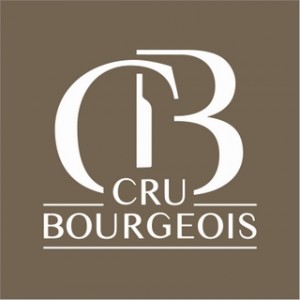Crus Bourgeois 2008 list announced
The list of 243 cru bourgeois wines for the 2008 vintage was announced last week.

New logo, on every bottle from the 2009 vintage onwards
The term cru bourgeois has undergone a lot of change in the last few years after the debacle, in 2003, of re-creating this historic group of growers into an official classification. It is now an annual award of vintage quality based on a blind tasting in the months before bottling. Thus the 2008 vintage is the first to be announced, under this new system, in 2010.
In 1932, the term was first coined for a group of 444 châteaux in the Médoc. At the time it was not made into an official classification. An attempt was made to change this in 2003, when, after a selection and tasting process, the French government ratified the first official classification of 247 châteaux, out of a total of 490 châteaux that had applied for the designation.
However a number of châteaux took legal proceedings against the classification, arguing it had not been carried out fairly, and the classification was annulled in 2007. Outgoing president of the Alliance des Cru Bourgeois du Médoc, Thierry Gardinier, owner of Château Phélan Ségur said “it was a tough time. But we decided to rebuild something [to keep] the international name of cru bourgeois, but we couldn’t use the base of the old system. We needed to do something coming from the wines, not the estates.”
In the subsequent three years, work has been going on to create this entirely new system that preserves the heritage and positive image of cru bourgeois wines, and leaves behind the disarray. Gardinier said “the classification is not based on property or terroir. It is based on wine. Wine which is tasted each year. It is not the château which is recognised, but it is the wine which is recognised as being able to be cru bourgeois.”
This is an important departure for Bordeaux – that the wine, and not the property achieves cru bourgeois. And so, it is an annual award which must be applied for each year. Any château in the eight Médoc communes of Médoc, Haut-Médoc, Listrac-Médoc, Moulis en Médoc Margaux, Saint Julien, Pauillac and Saint Estèphe may apply.
The whole process is overseen by the independent compliance and certification laboratory Bureau Véritas. Of the 290 Châteaux that applied for cru bourgeois for their grand vin – it cannot be cuvée – from the 2008 vintage, all were visited and assessed by Bureau Véritas according to the requirements for production facilities and traceability laid down by the Alliance. Passing this assessment makes a Château eligible to apply for cru bourgeois. Properties will be re-checked by Bureau Véritas at least every five years. Any new châteaux applying for the 2009 vintage that have not already been checked by Bureau Véritas will need to have their eligibility confirmed by the laboratory.
Wines are submitted for blind tasting by panels of professionals, and who have no direct family connection to the châteaux. No château owners are allowed to be part of the panels. The tasting panels are also verified by Bureau Véritas.
Each year a minimum benchmark of quality will be set for that vintage, using an average of ten representative wines, and which is representative of the vintage, and which takes account of vintage variation.
A number of tastings for cru bourgeois status are held between February and July, so, Gardinier said “if you are not accepted first time, you can adapt your blend and present it to the next tasting. But the wine passed has to [match] the volume put on the market.” He added “the system is controlled by Bureau Véritas. We [the Alliance] keep a second sample. And we can purchase the wine one, two, three years later” so anyone trying to cheat the system is likely to be found out. Bottling must be declared, so the Alliance can take a sample for analysis.

Frédéric de Luze
Gardinier has passed on the baton of presidency to Frédéric de Luze, owner of Château Paveil de Luze in Margaux. After 15 years as part of the cru bourgeois association Gardinier said “I’ve been president for six years. My first mandate was in 2004, when there was a [political] storm in the Médoc, we had hard time. Phélan Ségur was a cru bourgeois exceptionelle because of the 2003 classification, but our property had not used cru bourgeois on the label. In 2007, the classification was cancelled, and I knew to rebuild cru bourgeois we needed no hierarchy.” Gardinier was asked to stay on, and was re-elected as president, just one month after the collapse of the previous classification. He said “I decided not to leave then, I had to finish the job [of rebuilding cru bourgeois].” And, he said, having now withdrawn Phélan Ségur from the cru bourgeois system, “I cannot be part of an association in which my Château is not part.”
Phélan Ségur is not the only ‘big name’ missing from the roll call of cru bourgeois. The new president, de Luze, said “most of the missing names are waiting to see what happens with 2008.”
And, with retail prices in France for cru bourgeois wines varying from €7 to €25+, de Luze hinted of a possibility of a hierarchy returning in the future, saying “it’s too early to develop. We have to take our time so people get used to it. After that it might happen that we organise a new classification in the selection. But for consumers, today if they can identify cru bourgeois as a reference it will be the first thing” they achieve positively. The Alliance must also get consumers ready to look out for the new list every year.
The full list will be published here.
The list of cru bourgeois for the 2009 vintage will be announced in September 2011.



